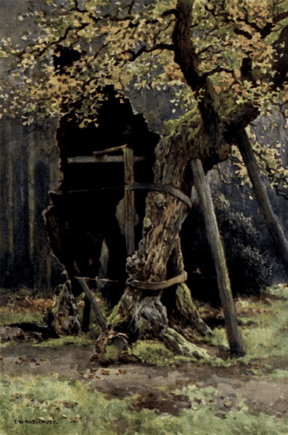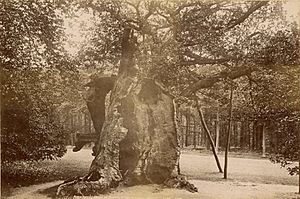Robin Hood's Larder facts for kids
Quick facts for kids Robin Hood's Larder |
|
|---|---|

Robin Hood's Larder in a 1913 painting by Ernest William Haslehust
|
|
| Location | Near Ollerton, Nottinghamshire |
| Date felled | 1961 (during a gale) |
| Custodian | Land now owned by the Forestry Commission |
Robin Hood's Larder was a very old and famous tree in Sherwood Forest. People also called it the Butcher's Oak, the Slaughter Tree, or the Shambles Oak. This huge tree had a trunk that was about 24 feet (7.3 meters) around!
The tree was hollow inside for a long time. It is said that the legendary outlaw Robin Hood and his friends used this hollow space. They supposedly stored meat they had hunted there, like a secret fridge! The tree was damaged by fires in the late 1800s and again in 1913. Sadly, a strong wind storm (a gale) knocked the tree down in 1961. Today, there is no sign of it left.
Where Was Robin Hood's Larder Located?
This special oak tree grew in a part of Sherwood Forest called Birklands. This area was first mentioned way back in 1251. It was owned by the royal family for 600 years!
The tree was about 3 miles (4.8 km) west of a village called Ollerton. It was also about 1.5 miles (2.4 km) west of another famous tree, the Major Oak. Today, the land where the tree once stood belongs to the Forestry Commission. The Sherwood Forest Visitor Centre is also nearby.
How Did the Tree Get Its Name?
The name "Robin Hood's Larder" comes from its connection to the famous legend of Robin Hood. People believed that Robin Hood used the tree's hollow trunk. He would store venison (deer meat) that he had hunted from the royal forest.
Storing hunted meat in hollow trees was common long ago. This was before people had refrigerators. So, even if the Robin Hood stories are just legends, it's very likely that hunters used the tree this way. Some stories say that hooks for hanging meat could still be seen inside the tree. But these hooks were gone by 1913.
Because of this legend, the tree had other names too. It was called the Butcher's Oak or the Slaughter Tree. The name Shambles Oak came from "shambles," which was an old word for a place where butchers worked.
What Is the History of Robin Hood's Larder?
A travel guide from 1874 talked about the tree. It said that a person named Hooton once used the tree to hang stolen sheep. At that time, the hollow trunk was so big that 12 people could fit inside! Later, people added iron bars and cables to help support the tree.
Towards the end of the 1800s, the tree was badly burned. This fire started when some schoolgirls were boiling a kettle inside the hollow trunk. In 1913, the tree was damaged by another fire, this time started by picnickers.
In the same year, a writer named Robert Murray Gilchrist wrote about the tree. He described it as "an old, old man who will be brave to the end." Gilchrist noticed that the tree didn't have many leaves. However, its upper branches stayed alive until after 1938. In 1938, the trunk was 24 feet (7.3 meters) around. About a quarter of this was the hollow space inside.
Finally, a big wind storm in 1961 caused Robin Hood's Larder to fall. Today, there is nothing left of this historic tree.


